Premium Only Content

🦃🍗 Happy Thanksgiving Everyone 🍁🍂 Found Me Some Organic Turkey On My Hike In The Trails 🦃🍗
Is Thanksgiving Day a Public Holiday?
Thanksgiving Day is a national public holiday in Canada. Many people have the day off work and all schools and post offices are closed. Many stores and other businesses and organizations are also closed. Public transport services may run to a reduced timetable or may not run at all.
In New Brunswick, Thanksgiving Day is a prescribed day of rest, meaning that businesses must be closed. Nova Scotia treats this day as a retail closing day, when some retail businesses are not allowed to open and employees have a legal right to refuse to work. While this is not a public holiday in Prince Edward Island, it is a holiday for federal employees and institutions in the province, and many shops, businesses, and schools are closed.
What Do People Do?
Many people have a day off work on the second Monday of October. They often use the three-day Thanksgiving weekend to visit family or friends who live far away, or to receive them in their own homes. Many people also prepare a special meal to eat at some point during the long weekend. Traditionally, this included roast turkey and seasonal produce, such as pumpkin, corn ears and pecan nuts. Now, the meal may consist of other foods, particularly if the family is of non-European descent.
The Thanksgiving weekend is also a popular time to take a short autumn vacation. This may be the last chance in a while for some people to use cottages or holiday homes before winter sets in. Other popular activities include outdoor breaks to admire the spectacular colors of the Canadian autumn, hiking, and fishing. Fans of the teams in the Canadian Football League may spend part of the weekend watching the Thanksgiving Day Classic matches.
Background and Perspectives
The native peoples of the Americas held ceremonies and festivals to celebrate the completion and bounty of the harvest long before European explorers and settlers arrived in what is now Canada. Today, some in the Indigenous People´s communities are calling for Canadians to raise their awareness of the toll that European settlement had on native tribes as they hold their Thanksgiving celebrations.
7 holidays with dark histories
Early European thanksgivings were held to give thanks for some special fortune. An early example is the ceremony the explorer Martin Frobisher held in 1578 after he had survived the long journey in his quest to find a northern passage from Europe to Asia.
Many thanksgivings were held following noteworthy events during the 18th century. Refugees fleeing the civil war in the United States brought the custom of an annual thanksgiving festival to Canada. From 1879, Thanksgiving Day was held every year but the date varied and there was a special theme each year. The theme was the "Blessings of an abundant harvest" for many years. However, Queen Victoria's golden and diamond jubilees and King Edward VII's coronation formed the theme in later years.
From the end of the First World War until 1930, both Armistice Day and Thanksgiving Day were celebrated on the Monday closest to November 11, the anniversary of the official end of hostilities in World War I. In 1931, Armistice Day was renamed Remembrance Day and Thanksgiving Day was moved to a Monday in October. Since 1957, Thanksgiving Day has always been held on the second Monday in October.
Symbols
Thanksgiving Day in Canada is linked to the European tradition of harvest festivals. A common image seen at this time of year is a cornucopia, or horn, filled with seasonal fruit and vegetables. The cornucopia, which means "Horn of Plenty" in Latin, was a symbol of bounty and plenty in ancient Greece. Turkeys, pumpkins, ears of corn and large displays of food are also used to symbolize Thanksgiving Day.
-
 14:22
14:22
Forrest Galante
13 hours agoDoes The Megalodon Still Exist?
52.1K6 -
 26:48
26:48
Stephen Gardner
8 hours ago🔥BREAKING: Vladimir Putin JUST shocked NATO | Will only negotiate with Trump!
106K138 -
 2:45:39
2:45:39
Tundra Tactical
11 hours ago $27.76 earnedTundra Nation Live : The Worlds Okayest Gun Live Stream
52.9K1 -
 17:06
17:06
Professor Nez
8 hours ago🚨BREAKING: Elon Musk to BUY MSNBC!? Dems STUNNED by Brian Williams’ Viral Video!
46.1K47 -
![If You Smell LALALALA What CHiLi IS COOKING!!... #RUMBLETAKEOVER [Overwatch 2]](https://1a-1791.com/video/s8/1/e/s/X/3/esX3u.0kob-small-If-You-Smell-LALALALA-What-.jpg) 4:27:40
4:27:40
CHiLi XDD
11 hours agoIf You Smell LALALALA What CHiLi IS COOKING!!... #RUMBLETAKEOVER [Overwatch 2]
27.9K1 -
 LIVE
LIVE
Delnorin Games
11 hours ago🔴 Live - Star Citizen
1,982 watching -
 1:39:44
1:39:44
HELMET FIRE
13 hours agoDEADROP IS BACK!
143K8 -
 10:03
10:03
Tundra Tactical
15 hours ago $15.10 earnedBrandon Herrera Vies Bid for ATF Director!
92K16 -
 22:01
22:01
DeVory Darkins
1 day ago $36.29 earnedHakeem Jeffries SHUTS DOWN The View as Matt Gaetz Speaks out
80.8K127 -
 2:02:54
2:02:54
Mally_Mouse
14 hours agoLet's Play!! - Spicy Saturday
60.3K2